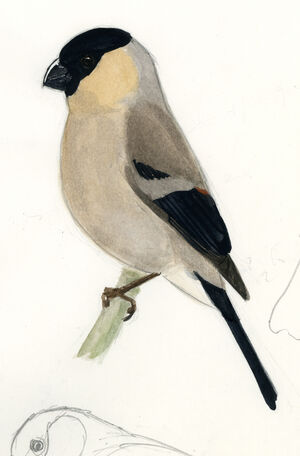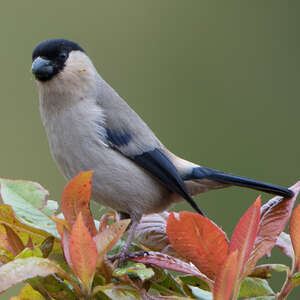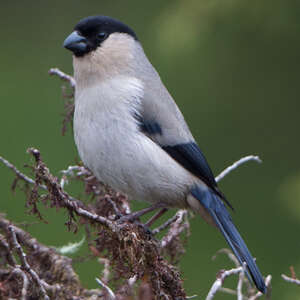Azores Bullfinch
Pyrrhula murina - Bouvreuil des Açores
Identification
The Azores Bullfinch, or Priôlo in Portuguese, has the same size, silhouette and posture as the Common Bullfinch, but can easily be distinguished by the colour of its plumage. Unlike the latter, there is no significant sexual dimorphism.
The adult resembles the female Common Bullfinch; the disposition of the black parts on its head, wings and tail is the same, and the black is glossy with dark blue reflections. The rest differs; the upper parts (neck, mantle, back and wing covers, except the base of the great covers which is black) are a medium grey tinged with beige. The throat and cheeks have a characteristic salmon colour. The rump is slightly the same colour as the cheeks, but never white like P. pyrrhula. There is no white on the wings either. The upper tail covers are black like the rectrices. The underside is a grey-white with a very slight pink or vinous hue. The under tail covers are the same colour as the cheeks, slightly more pronounced in the male. The iris is very dark. The black bill is even bigger than that of P. pyrrhula. The legs are a reddish brown.
The juvenile is similar to the adult but with a reddish hue on the great covers.
Subspecific information monotypic species
Foreign names
- Bouvreuil des Açores,
- Camachuelo de las Azores,
- priolo,
- Azorengimpel,
- azori-szigeteki süvöltő,
- Azorengoudvink,
- Ciuffolotto delle Azzorre,
- azorisk domherre,
- Asordompap,
- hýľ azorský,
- hýl azorský,
- Azorer-dompap,
- azorientulkku,
- pinsà borroner de les Açores,
- Asorpápi,
- gil azorski,
- azorski kalin,
- Азорский снегирь,
- アゾレスウソ,
- 亚速尔灰雀,
- azordomherre,
- 葡萄牙灰腹灰雀,
Voice song and call
The usual call which allows one to spot the bird in it dense habitat is a iuh that is very close to the Eurasian Bullfinch's call, but a bit softer and sometimes a bit trumpet-like with agitation. Up close, one can hardly hear small contact calls of high-pitched tones, like distant trumpet notes, that mark its presence. It's song is a slow succsession of notes, some of them recalling its call, and others a bit harder and contrasting.
Habitat
The Azores Bullfinch is endemic to the laurel forest, above 400 m in altitude. This habitat consists of the native woody species, Azores Laurel Laurus azorica, Azores Holly Ilex azorica, Erica azorica heath, Juniperus brevifolia juniper, Prunus lusitanica ssp azorica cherry, Vaccinium cylindraceum bilberry, and Viburnum treleasei viburnum.
Behaviour character trait
The Azores Bullfinch leads a discreet life in its dense shrubby and arboreal habitat that often resembles an impenetrable scrub.
If it weren't for its distinctive call, it would easily go unnoticed. But when you are attentive and keep your ears open, it is easy to spot it. It is not a shy bird and, with a bit of luck, you can have some beautiful close encounters. It often leaves its closed habitat in search of the herbaceous plants it feeds on, for example on the side of roads and in cut areas and forest replantations.It is usually observed in pairs, or in small family groups after reproduction.
It is of course a sedentary species, simply subject to some seasonal altitudinal movements.
Dietfeeding habits
The Azores Bullfinch is a strict vegetarian, consuming a variety of seasonal seeds, vegetative and floral buds, inflorescences, and fruits.
We have observed their appetite for a herbaceous plant, Scrophularia with earlobes, whose floral buds are consumed early in the season and later its seeds. The Hollies of the Azores is known to play a major role, particularly as an alternative food in case of shortage of other items, andApril is a critical moment when the species resorts to its flowers. Early in the season, it also readily exploits young branches of the Azores Laurels. It is also the only local species to consume spores and young fronds of ferns or moss capsules. It is also capable of taking advantage of allochthonous species such as the small knotweed Polygonum capitatum, which it consumes for its flowers or the Prunella vulgaris for their seeds. In total, 37 plant species are part of the diet of the bullfinch.Reproduction nesting
The Azores Bullfinch is relatively poorly known. Reproduction is known to occur late, by June. There would seemingly be two successful clutches. Its nest is reported to be placed high in a tree, over 5 meters up, like in a Japanese Cedar for example. But before that exotic tree was planted, the nest used to be made out of a native kind such as Azores Juniperus microphylla.
The nest looks similar to the Crossbill nest. It usually lays two to three eggs.
Geographic range
The distribution of the Azores Bullfinch is restricted to the island of Sao Miguel in the Azores Archipelago. And on this island, it can only be found in the mountainous northeast part in a limited area where its habitat is present, between Nordeste in the north and Povoação in the south. The area is centered on the Pico da Vara, the summit of the island, and its center of gravity is the Serra da Tronqueira.
Threats - protection
IUCN conservation status
concern
in the Wild
threatened
evaluated
At first, the Azores Bullfinch was a common bird in its widespread habitat. The arrival of man in the 15th century changed everything, with the gradual destruction of the laurisylve forestry for agriculture, horticulture, and then forestry. The bullfinch is completely dependent on this habitat. Furthermore, early on, exotic species were introduced which often took precedence over native vegetation. During the period when the island was oriented towards the production of citrus fruits, the Azores Bullfinch, which ate the floral buds of fruit trees, was considered a pest and was consequently destroyed. This stopped when this farming was abandoned. Then, it was the dairy period which required land. This land was obviously obtained in part from the bullfinch's habitat, and this continues to this day. It should be known that the Azores account for 25% of the dairy production of Portugal. Finally, as if this were not enough, vast areas of medium altitude were planted with Japanese Cedar Cryptomeria japonica, a devastating monoculture for the bullfinch's habitat which gradually became reduced to very little. The result was a drastic decrease in its population which in the 20th century was in danger of becoming critically extinct, with around 200 individuals counted. It was and still is one of the most endangered European species.
If one wanted to avoid the extinction of the species, urgent measures were necessary. As of 2003, conservation measures started as part of the Priolo program, which ended in 2008. Another Life program, called Laurisilva, succeeded it and has been ongoing since the beginning of 2009, on the same topics. These programs are coordinated by the SPEA (Portuguese Society for Bird Study).The goal of these actions is to restore a laurel forest by controlling invasive species and replanting native species. This forest won't be exactly like the original one, but it will get close, and that will benefit the Azores Bullfinch greatly. And these actions are beginning to bear fruit, since the population of bullfinches has risen to around 800 individuals in the mid-2010s, and is expected to keep growing. The species moved from Critically Endangered to simply Endangered.
Sources of information
- IOC World Bird List (v15.1), Gill, F and D Donsker (Eds). 2025-12-07.
- Birds of the Atlantic Islands, Clarke Tony
- Avibase, Lepage Denis
- HBW Alive,
- O Priolo e afloresta natural de altitude , Ramos Jaime Albino
- xeno-canto, Sharing bird sounds from around the world,
Other sources of interest
 Specification sheet created on
27/07/2023 by Jean François
Specification sheet created on
27/07/2023 by Jean FrançoisTranslation by AI Oiseaux.net
© 1996-2025 Oiseaux.net
- Accipitriformes
- Aegotheliformes
- Anseriformes
- Apodiformes
- Apterygiformes
- Bucerotiformes
- Caprimulgiformes
- Cariamiformes
- Casuariiformes
- Charadriiformes
- Ciconiiformes
- Coliiformes
- Columbiformes
- Coraciiformes
- Cuculiformes
- Eurypygiformes
- Falconiformes
- Galliformes
- Gaviiformes
- Gruiformes
- Leptosomiformes
- Mesitornithiformes
- Musophagiformes
- Nyctibiiformes
- Opisthocomiformes
- Otidiformes
- Passeriformes
- Pelecaniformes
- Phaethontiformes
- Phoenicopteriformes
- Piciformes
- Podargiformes
- Podicipediformes
- Procellariiformes
- Psittaciformes
- Pterocliformes
- Rheiformes
- Sphenisciformes
- Steatornithiformes
- Strigiformes
- Struthioniformes
- Suliformes
- Tinamiformes
- Trogoniformes























